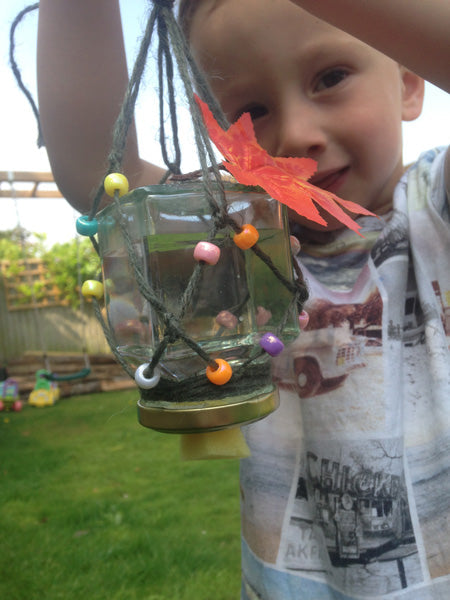Little Explorers: Make a Butterfly Feeder
- Little Explorers

Who doesn’t love to see a butterfly flutter by? They stop you in your tracks as you take a moment to pause and watch one of the beauties of nature and forget about everything else. They’re also one of Britain’s super pollinators so we decided to try and attract more into the LittleLife HQ garden by making a butterfly feeder.

You will need:-
- A glass jar
- Garden twine
- Shiny beads
- Small foam cut offs
- Sugar
- Fake flowers
- Hammer and nail

This is a great activity to keep Explorers of all ages busy in the summer holidays. It’s a good one for getting siblings to work on together because older children can do the trickier aspects with a little help from you.
The idea is to create a jar full of butterfly nectar (sugar water) that hangs upside down in the garden, with the nectar slowly soaking onto a piece of foam that is lodged in the underside. The butterflies will land here and feed.
Knock a nail into the centre of the jar lid to make a small hole. Take a small oblong of foam (3-4 cm long) and prod, tickle and poke it until it is firmly lodged halfway through the small hole. This is a tricky task – excellent for keeping older Explorers occupied for a while!

Then you’ll need to create a macramé-ish style net of string and pretty beads that will keep the jar hanging level and upside down. There are many different ways of doing this – trial and error is really your best bet unless you’re expecting this to be good enough to sell! We tied four arm-length pieces of string around the neck of the jar, threaded beads on it, crossed the strings over, tied and repeated the process until it held the jar securely.

The beads not only make it look attractive to us, but to the butterflies too! You can glue fake flowers on for extra beautifying.

Make your butterfly nectar from one-part sugar to nine parts water. Heat the water so the sugar melts completely and cool it before allowing your Little Explorers to pour it into the jar. Ask them to screw the lid on tightly and turn it upside down. Check the foam is drawing down the nectar, then hang it in a prominent place on a tree or bush – and wait for the butterflies!
Send us your pictures if you snap one when a butterfly is feeding – we’d love to see it. You can identify any visitors you attract using this great guide from Butterfly Conservation.

Expert Explorers: You know the story of The Very Hungry Caterpillar who eats and eats then goes into his chrysalis and emerges as a beautiful butterfly? Well, did you know that while it is inside its pupal case, the caterpillar’s body dissolves into a kind of soup which, over the course of around 10-15 days, turns into an adult butterfly. Incredible stuff. And all for a short life of just two weeks on average.
Butterflies have a crucial role in pollinating plants. There are 59 species of butterfly and 2,500 species of moths. However, they are one of the most threatened groups of wildlife in the UK so let’s do our best to conserve them.


